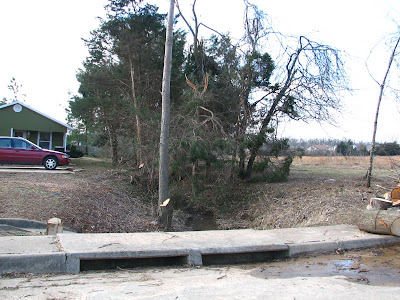Please click on image to ENLARGE view of dump truck full of red dirt being hauled to construction site in Fayetteville, Arkansas.

Please click on images to ENLARGE photos.

In the photo above, a layer of something approximating topsoil has been spread over red dirt used in trail construction but the chances of a strong enough crop of grass and other natural vegetation taking hold there to prevent erosion on a slope is questionable. Erosion from this site enters Scull Creek, a tributary of the Illiinois River.
In the photo below, red dirt has been built up several feet for the foundation of a strip shopping center in the riparian zone of a tributary of Fayetteville's Town Branch of the West Fork of the White River.

The story linked below is about as good as it gets for coverage of local resident/environmental groups' meetings. However, it is important to note one mistake, a mistake that may explain why comments about red dirt in water-quality discussions never get quoted by local reporters.
Red dirt is misunderstood.
Red dirt is not "rich, red dirt." A soil expert may be able to tell us about "rich, red dirt" someplace on earth. But "red dirt" in Northwest Arkansas is not topsoil even when one sees it on the surface. The natural topsoil has been removed by the mining process of scraping away the soil found above it.
The red dirt found in Northwest Arkansas is non-organic dirt that will not sustain life. It is stone and clay that has been hidden under a layer of organic soil for eons.
"If God had been proud of red dirt, God would not have buried it out of sight," said one Northwest Arkansas natural-resource conservationist speaking about its use on construction sites.
Road-builders and contractors putting up buildings use red dirt for foundation material. Some engineers and planners and developers call red dirt "good dirt" for their purposes. However, red dirt is the opposite of good for growing food or trees or flowering plants. Contractors who spill it beyond the bounds of a foundation quickly hide it under a layer of some type of organic soil that will at least grow a bit of grass.
But that means the possibility of raising a healthy garden or having a tree grow successfully for the long term is impossible forever, or at least until the red dirt is removed! Whole subdivisions may be found with solid red dirt where truly rich almost black topsoil formerly created fertile prairie land with the immense potential for agriculture and wildlife habitat. NOTHING LIVES IN OR ON RED DIRT. Human beings and other living things depend on organic soil for their existence.
Basically, red dirt-covered development sites are as impervious to water as paved lots. Stormwater runs off rapidly because it cannot soak in. The elements that erode from red dirt discolor streams and lakes and rivers and the silt doesn't stop discoloring the water for a long, long time. Native lIfe in streams decreases permanently after such changes in the watershed.
So, please, editors and reporters, let's not use the words "rich" and "red dirt" together. Certainly, people selling lots of red dirt may be enriched. But their product is not "rich" as an agricultural or environmental expert would use the word.
West Fayetteville serious about fighting red-dirt and limestone quarry Neighbors decry noise, effects of blasting at Big Red Dirt Farm
BY DUSTIN TRACY Northwest Arkansas Times
Posted on Tuesday, February 17, 2009
URL: http://www.nwanews.com/nwat/News/74075/
They're tired of the blasting, they're tired of the noise at all hours of the night and they certainly don't want to see the Big Red Dirt Farm, just off Hamstring Road north of Wedington Drive, converted into a limestone quarry.
That's why members of the West Fayetteville Citizens for Environmental Quality asked Ward 4 Aldermen Shirley Lucas and Sarah Lewis at the group's meeting Monday for the City Council's help in the battle against what has become a noisy, arguably dangerous, big hole in a number of resident's backyard.
"Quarry blasting on the edge of city limits can't be a good thing," Dave Bolen, president of the group, said.
The issue dates back to 2004, when about 50 acres were purchased by the William G. Sweetser Trust and A. Brad Johnson, who began farming the land for its rich, red dirt. Soon, the company decided to harvest the pillars of limestone that ran up through the dirt. Bolen said that was when his headaches started.
"They decided to fire up a rock crusher at 9:30 p.m. on a Saturday night," Bolen told Lucas and Lewis.











.jpg)






